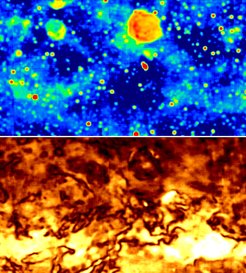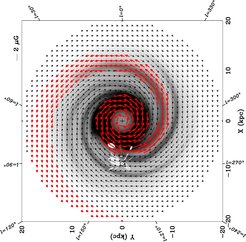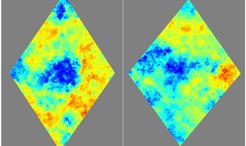Research Interest - Galactic Magnetism and the Milky Way
Continuum Surveys

Since the foundation of the MPIfR, continuum surveys of the Galactic plane have been conducted at different frequencies in order to reveal the physical properties of the observed objects and of the diffuse emission. Most of these surveys are available at the Survey Sampler of the MPIfR.
The Effelsberg 1.4-GHz Medium Galactic Latitude Survey (EMLS), which is currently in the reduction phase, is a continuum and polarisation survey of the northern Galactic plane covering the latitude range of ± 20° with an angular resolution of 9.35’. The survey is confusion limited in total intensity at a noise level of 7 mJy/beam (or 15 mK TB). The noise level in Stokes U and Q is 4 mJy/beam. The most spectacular results come from the polarisation maps, which show an unexpected richness in structure with almost no counterpart in total intensity. Variations in the Faraday rotation within the magneto-ionic interstellar medium are responsible for the observed structures. Numerous so-called "Faradays screens" - i.e. 3-dimensional features with an ordered magnetic field - are indicated in the maps. Absolute calibration is essential for the interpretation of polarised structures. These data were provided by a new low-resolution northern-sky survey carried out with the DRAO 26-m telescope (Canada). The data of this survey as well as first sample maps of the EMLS are available at the MPIfR's Survey Sampler.
Electron density model
To determine pulsars' distances from their observed dispersion measures, or to derive the structure of the magnetic field of the Milky Way from the rotation measures of pulsars or extragalactic sources, requires a detailed understanding of how electrons are distributed throughout the Milky Way. We have investigated how well eight electron density models that have been proposed by various authors, predict the distances of pulsars for which distances could also be measured directly (measured parallaxes, or association with globular clusters). Additionally, we developed four new models. It turns out that the distances that can be derived from the current generation of electron density models are not very accurate; together with colleagues at other institutes we are developing the next generation of models.
Magnetic Fields in the Milky Way

The overall structure of the magnetic field of the Milky Way is much more difficult to determine than in nearby galaxies, because of the position of the solar system within the disk of the Milky Way. On the other hand, magnetic field studies of the Milky Way reveal details on magnetised objects, like supernova remnants, and small-scale turbulent structures, which can not be observed in any nearby galaxy.
Faraday rotation measurements from pulsars with known distances and from extragalactic sources shining through the Milky Way were used to construct a model of the Milky Way’s large-scale magnetic field in three dimensions. The overall magnetic field structure follows the optical spiral arms, in the same way as it is observed in other galaxies. One large-scale field reversal in the disk inside the solar radius has been found, which is so far unique in respect to what is known about nearby galaxy fields. The strength of the regular and the turbulent magnetic field component in the solar neighbourhood are of the same order, e.g. a few micro-Gauss. The strength of the magnetic field increases towards the Galactic Centre region and is significantly higher there, also indicated by recent measurements from the first pulsar in the Galactic Centre (press release). The disk field is symmetric with respect to the Galactic plane. The weaker halo magnetic field was found to be toroidal and antisymmetric (i.e. it has different directions above and below the Galactic plane).
Simulations of the polarised intensity

Models of the Galactic magnetic field were constructed using all-sky maps in total intensity at low and high frequencies. In addition, all-sky maps in polarised emission at 1.4 GHz (DRAO 26-m and Villa Elisa 30-m telescopes) and 22.8 GHz (WMAP) were used in combination with extragalactic RMs in the Galactic plane and high latitudes for a reliable 3D-magnetic-field-model, which is in agreement with all available observations. This 3D-model allows to view the Milky way from outside in all directions, showing a much smaller halo extent than previously assumed. The 3D-model is also helpful to interpret nearby Galaxy observations. Based on the Milky Way model, we simulated low-resolution sky maps, as they will be observed with LOFAR. Arcsec simulations of the diffuse Galactic emission and the RM distribution for extragalactic sources were made for small fields as part of the ‘SKADS Science Simulations’, which are needed for estimates of the Galactic foreground influence on SKA observations of extragalactic objects or low-frequency experiments to detect signals from the Epoch of Reionization. Another aspect of the SKADS science simulations uses dynamo theory to derive the timescales of amplification and ordering of magnetic fields in galaxies. Based on models describing the formation and evolution of dwarf and disk galaxies, an evolutionary model of turbulent and regular magnetic fields was developed, with several predictions that can be tested observationally.


